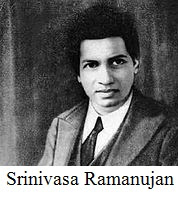Biography of Srinivasa Ramanujan:
Srinivasa Ramanujan (1887–1920) was an Indian mathematician who made significant contributions to mathematical analysis, number theory, infinite series, and continued fractions. His self-taught and unconventional methods led to groundbreaking discoveries and the development of new mathematical theories.
Here is a brief biography of Srinivasa Ramanujan:
Early Life:
1. Birth and Childhood:
Srinivasa Ramanujan was born on December 22, 1887, in Erode, Madras Presidency (now in Tamil Nadu, India), in a Tamil Brahmin family.
 |
| Biography of Srinivasa Ramanujan |
2. Educational Background:
Despite facing financial difficulties, Ramanujan excelled in mathematics from a young age. His formal education was at the Town Higher Secondary School in Kumbakonam.
Self-Taught Genius:
1. Interest in Mathematics:
Ramanujan developed a passion for mathematics at an early age and independently studied various mathematical books.
2. Mathematical Discoveries:
He made substantial mathematical discoveries on his own, delving into complex areas of mathematics, such as number theory, without formal training.
3. Correspondence with Mathematicians:
Ramanujan began corresponding with renowned mathematicians, including G. H. Hardy, in England, sending them samples of his work.
Move to England:
1. Contact with G. H. Hardy:
G. H. Hardy, a prominent mathematician at the University of Cambridge, recognized Ramanujan’s talent and invited him to England.
2. Cambridge University:
Ramanujan arrived in England in 1914 and began working with Hardy at Cambridge University.
Mathematical Contributions:
1. Mock Theta Functions:
Ramanujan’s work on mock theta functions and q-series significantly impacted the field of modular forms and brought new insights into number theory.
2. Ramanujan Prime and Ramanujan-Hardy Number:
He discovered the Ramanujan prime and the Ramanujan-Hardy number, which are named in his honor.
3. Partition Function:
Ramanujan made groundbreaking contributions to the partition function, revolutionizing the study of partitions in number theory.
4. Infinite Series:
His work on infinite series, divergent series, and continued fractions had a profound impact on mathematical analysis.
5. Lost Notebook:
After his death, a “lost notebook” containing some of Ramanujan’s unpublished work was discovered, leading to further mathematical discoveries.
Illness and Death:
1. Health Challenges:
Ramanujan’s health deteriorated during his time in England, and he faced health challenges, including severe bouts of illness.
2. Return to India:
Due to declining health, Ramanujan returned to India in 1919.
3. Death:
Srinivasa Ramanujan passed away on April 26, 1920, at the young age of 32, in Kumbakonam, Tamil Nadu.
Legacy:
1. Impact on Mathematics:
Ramanujan’s contributions to mathematics continue to influence various branches of the field, and his formulas and theorems are studied and celebrated worldwide.
2. Ramanujan-Hardy Number:
The number 1729 is known as the “Ramanujan-Hardy number” because of an incident where Hardy, visiting Ramanujan in the hospital, mentioned that he arrived in a taxi with the seemingly uninteresting number 1729. Ramanujan immediately pointed out that 1729 is actually a very interesting number—it is the smallest positive integer that can be expressed as the sum of two cubes in two different ways (1729 = 1³ + 12³ = 9³ + 10³).
3. Ramanujan Prize:
The Ramanujan Prize for Young Mathematicians, awarded by the International Centre for Theoretical Physics (ICTP), is named in his honor.
Srinivasa Ramanujan’s life and work continue to inspire mathematicians and scholars around the world. His story is a testament to the power of innate talent, dedication, and the pursuit of knowledge against all odds.